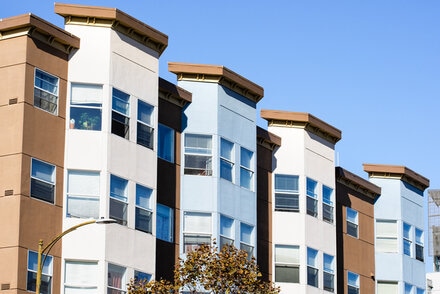
x
Andrew LaSalla
Andrew LaSalla II is one of the most trusted financial consultants in the residential and commercial lending business. With over seven years of of property loan underwriting experience, Andrew's sole focus is helping clients successfully navigate complex financial laws, terms, rules, paperwork, and transactions necessary to secure loans for new construction, purchase, or refinancing of multifamily, healthcare, affordable housing and student housing properties. Whether it's HUD, FHA, or MAP loans, Andrew is committed to tailoring financial solutions for every client he serves.
Debt service coverage ratio (DSCR) is a commonly used method to determine ability to pay off debt. Improving and maintaining a good DSCR is therefore important to anyone with a multifamily apartment loan. But how is DCSR calculated, and how can it be improved? Read on to find out more.
DSCR Calculation
When deciding how to calculate DSCR, it is important to ensure that you implement the same criteria as a majority of lenders use.
The most DSCR calculation formula is as follows:
Net Operating Income / Annual Debt Service = DSCR
The lender will have the underwriter follow these steps when calculating income and expenses to determine the DSCR.
To help you with your DSCR calculation bear in mind that the underwriter will:
- Utilize 5% to 7% vacancy depending on the loan program to calculate occupancy. Even if the project is 100% occupied, lenders use this measure to minimize risk.
- Prepare annual proforma for income and expenses.
- Use the current rents that reflect on the rent rolls. The lender will not use projected future rents.
- Use a 5% fee for management. Even if you self-manage or pay a lesser %, this is the average that most lenders use for qualification purposes.
- Make sure that the property taxes are reflected correctly in the expenses.
- In the expenses for the pro-forma, increase the expenses by approximately 3%, especially for utility expenses.
- Initial reserve for replacements should be calculated at $1,000 per unit, and can range anywhere from $250 to $400 per unit per annum thereafter. This account is for major repair items such as windows, roofs, HVAC systems, water heaters and major replacement items.
How to Improve DSCR
In order to maximize the size of your requested loan amount, there are different avenues that can be utilized to improve the Debt Service Coverage Ratio on the project.
Expenses & DSCR
In reviewing historical operating expenses, look for capital expenses that were expensed to repairs that will not re-occur annually. Also, expenses such as legal, insurance, and other expenses that were higher than previous years due to variables such as weather or maintenance that are unusual can be adjusted. The interest rate has a significant affect on the DSCR. In low rate environments like the one we are experiencing now, the loan proceeds will be higher as the debt that needs to be covered will decrease.
Loan Amortization
The loan amortization that a borrower chooses will also affect the DSCR. The longer the loan amortization, the lower the debt payment. Clients that are looking to refinance a project for the lowest fixed rates and longest amortizations should look into the HUD/FHA 223(f) program for refinancing or purchase. The maximum loan to values and debt service coverage ratios can be seen below:
- High LTV (loan-to-value) and low DSCR’s (debt-service-coverage-ratio’s)
- 85% LTV and 1.18% minimum DSCR for Market Rate Properties
- 87% LTV and 1.15% minimum DSCR for Affordable Properties
- 90% LTV and 1.11% minimum DSCR for Subsidized Properties
Effective Gross Income and Gross Potential income
When looking to invest in a multifamily apartment project it is important to understand the difference between effective gross income and the gross potential income.
- The gross potential income suggests the income if the property is 100% occupied.
- The effective gross income is the amount that is actually collected based on the occupancy percentage.
- If a property is 85% occupied, the effective gross income calculation is used to determine the cap rate or value of the multifamily apartment project.
Contact LSG Lending Advisors
For assistance with DSCR calculation, more tips to improve your DSCR and all lending advice, contact LSG Lending Advisors.